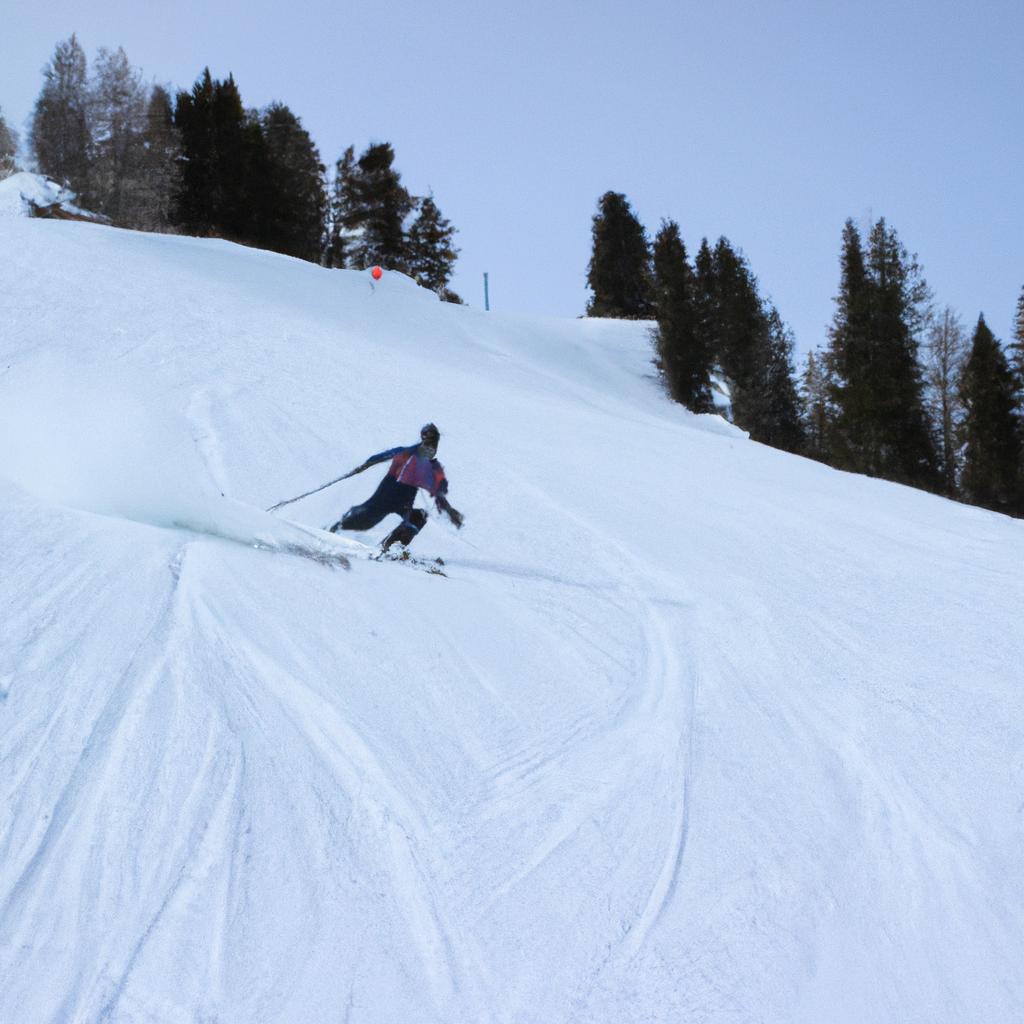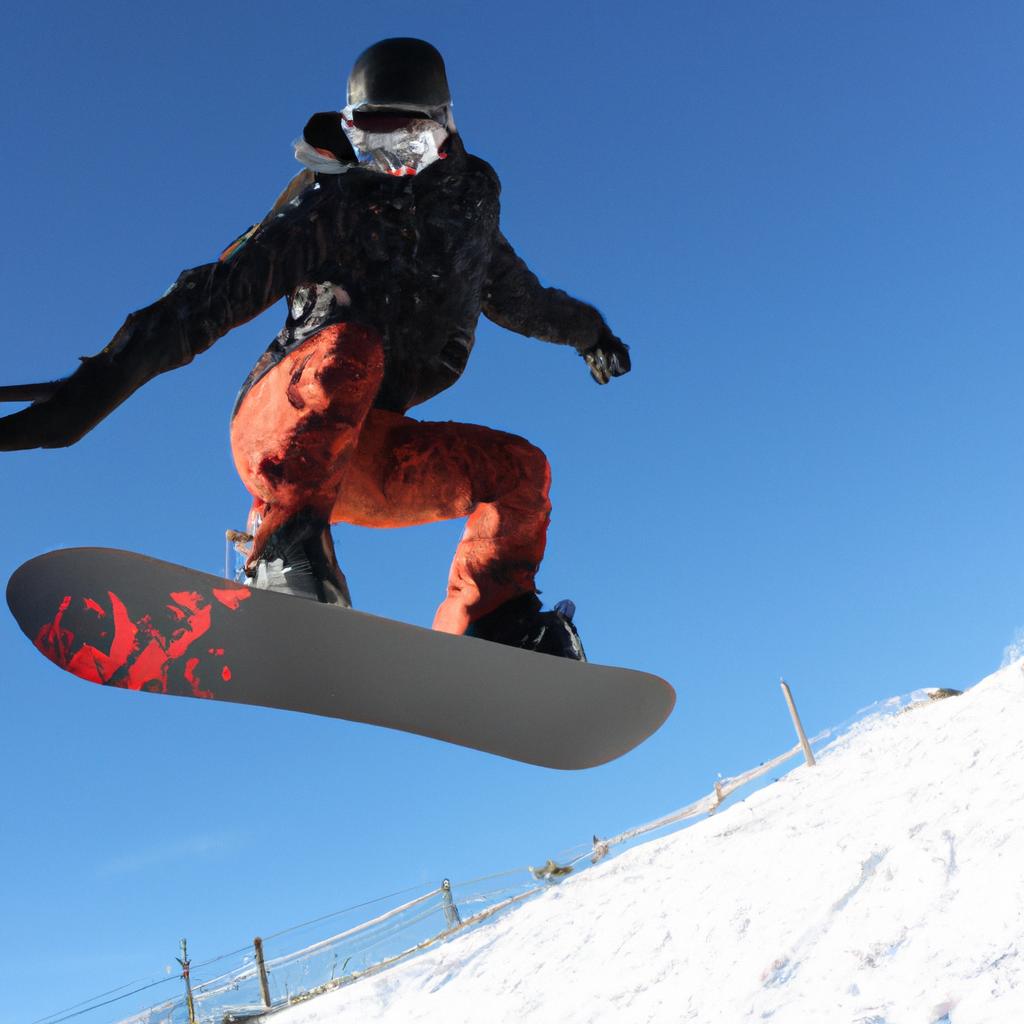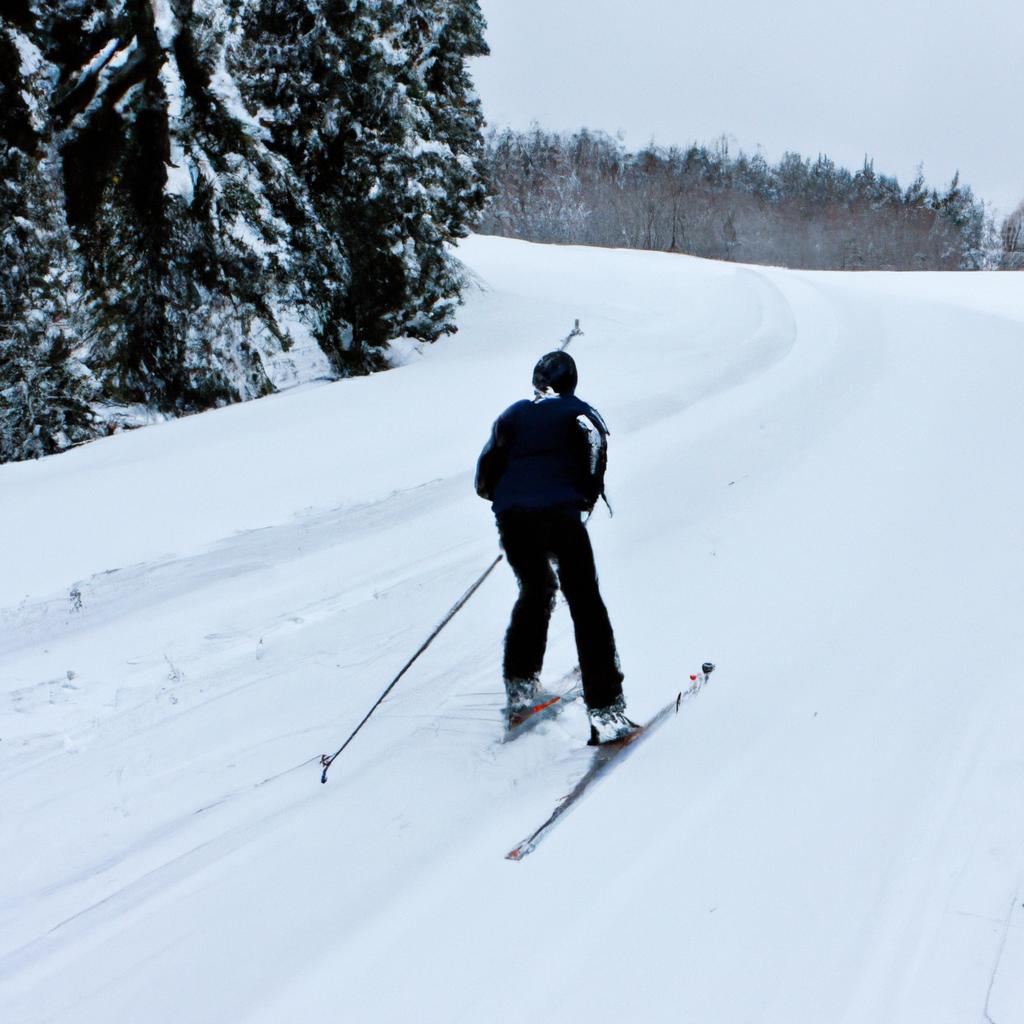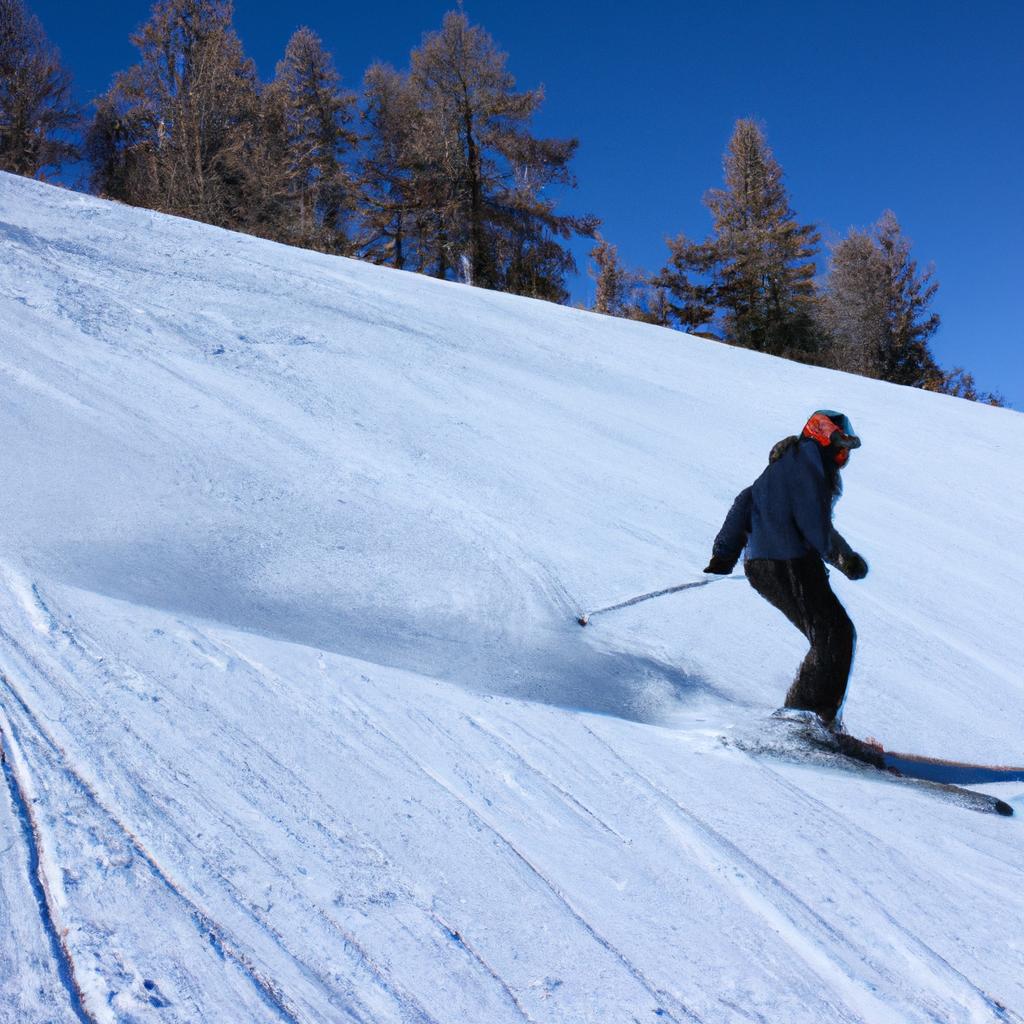Skiing is a popular recreational activity that offers individuals the opportunity to glide gracefully down snow-covered slopes, experiencing the thrill of speed and freedom. However, mastering the art of skiing requires more than just strapping on a pair of skis and heading downhill. It necessitates understanding essential techniques that enable skiers to navigate varying terrains with control and precision. By delving into the principles of balance, body positioning, and turning mechanics discussed in this article, aspiring skiers can enhance their skills and enjoy a safer and more gratifying experience on the slopes.
To illustrate the significance of these techniques, consider the hypothetical case study of Sarah, an enthusiastic novice skier who recently embarked on her first ski trip. Excitement filled her as she stood at the top of a steep slope, ready to conquer it head-on. However, lacking knowledge about proper technique quickly turned her exhilaration into frustration as she found herself struggling to maintain balance and control her descent. Had Sarah been aware of the crucial skiing techniques outlined in this article, she could have approached that challenging slope with confidence and skillfully maneuvered through it without compromising safety or enjoyment. Therefore, by acquiring an understanding of fundamental skiing techniques such as weight distribution, stance alignment, and carving turns – Sarah would have been able to navigate the slopes with ease and grace. Weight distribution is a vital aspect of skiing technique, as it allows skiers to maintain balance and control over their movements. By distributing her weight evenly between both skis, Sarah could have avoided the feeling of being off-balance and unstable on the slope. Additionally, understanding proper stance alignment would have helped Sarah maintain a centered position over her skis, allowing for smoother turns and better control.
Carving turns is another key technique that would have greatly benefited Sarah in her skiing endeavors. Carving involves using the edges of the skis to cut into the snow, creating clean and precise turns. By mastering this technique, Sarah would have been able to initiate turns more effectively, maintain speed control, and glide effortlessly down the slopes.
In conclusion, by familiarizing herself with essential skiing techniques such as weight distribution, stance alignment, and carving turns, Sarah could have transformed her initial frustrations into a successful and enjoyable skiing experience. These fundamental principles not only enhance skill but also contribute to safety on the slopes. With practice and knowledge of these techniques, aspiring skiers like Sarah can confidently tackle any slope they encounter while embracing the thrill and freedom that skiing offers.
Choosing the right equipment
Choosing the Right Equipment
Imagine yourself standing at the base of a snow-covered mountain, ready to embark on an exhilarating skiing adventure. Before you hit the slopes, it is crucial to ensure that you have chosen the right equipment tailored to your needs and skill level. This section will guide you through the essential considerations when selecting ski gear.
To begin with, it is important to determine your skiing ability and desired terrain. Whether you are a beginner or an advanced skier, different types of skis offer distinct advantages. For instance, if you primarily enjoy groomed trails and prefer quick turns, shorter length carving skis might be suitable for you. Conversely, longer all-mountain skis provide stability and control in varied conditions, including off-piste adventures.
Now let’s delve into some key factors to keep in mind when choosing ski equipment:
- Flexibility: The flexibility of a ski determines its responsiveness and performance on different types of terrain.
- Bindings: Bindings connect your boots to the skis and play a vital role in safety by releasing during falls or accidents.
- Boots: Properly fitted boots are crucial for comfort and control while skiing.
- Poles: Poles assist with balance, timing, and maneuvering on the slopes.
Consider this table as a visual aid that highlights additional aspects worth considering:
| Aspect | Description |
|---|---|
| Skier Type | Identifies whether you are a beginner, intermediate or advanced skier |
| Ski Length | Understanding how ski length affects performance |
| Skill Level | Determining which type of ski suits your proficiency |
| Terrain Type | Matching ski characteristics with preferred terrain |
By thoughtfully examining these points before making any purchase decisions, you can ensure that your equipment aligns perfectly with your skiing goals and abilities.
In transitioning toward mastering the basic stance required for successful skiing techniques—where balance and stability are paramount—we will explore essential techniques to enhance your performance on the slopes.
Mastering the basic stance
Imagine yourself standing at the top of a snow-covered mountain, ready to embark on an exhilarating skiing adventure. Before you rush down the slopes, it is crucial to master the basic stance that will serve as your foundation for all further techniques. By adopting the correct position and posture, you can ensure better balance, control, and ultimately enhance your overall ski performance.
To begin with, let’s explore some essential elements of the basic stance:
-
Alignment:
- Align your body perpendicular to the slope.
- Keep your hips facing downhill.
- Distribute weight evenly on both skis.
-
Flexion and Extension:
- Maintain a slight flex in your ankles, knees, and hips.
- Use this flexion to absorb shock during turns or uneven terrain.
- Extend your legs smoothly when initiating movement or increasing speed.
-
Upper Body Position:
- Face forward with your shoulders parallel to the slope.
- Avoid leaning back or hunching over; instead, stay upright and centered.
- Allow natural arm movements for maintaining balance.
-
Gaze Direction:
- Look ahead in the direction of travel.
- Focus on where you want to go rather than looking down at your skis.
By implementing these fundamental aspects into your skiing technique, you can establish a solid base from which to progress further. Remember that practice makes perfect – spend ample time refining your basic stance until it becomes second nature.
As we delve deeper into mastering skiing techniques, our next focus will be on perfecting the snowplow technique. This foundational maneuver allows beginners to gain confidence while controlling their speed effectively. With each step forward in our journey towards becoming proficient skiers, we unlock new possibilities for exploring breathtaking mountainsides.
Perfecting the snowplow technique
Transitioning seamlessly from mastering the basic stance, it is now time to delve deeper into perfecting the snowplow technique. Imagine you are gliding down a gentle slope, feeling confident in your skiing abilities. Suddenly, you encounter an unexpected patch of ice that sends you off balance. In this situation, having a solid grasp of the snowplow technique can make all the difference between regaining control and experiencing a potentially hazardous fall.
To begin with, let’s explore four key elements that contribute to mastering the snowplow technique:
- Body Position: Maintaining proper body alignment is crucial for executing an effective snowplow. By slightly bending your knees and keeping your weight centered over your skis, you can enhance stability and maneuverability. Additionally, leaning forward slightly promotes better control as you initiate the plowing motion.
- Edging: The angle at which you edge your skis determines how effectively they grip the snow. When performing a snowplow, gradually increase the amount of edging on both skis to create more friction against the ground. This increased resistance helps slow down momentum and provides greater control during turns.
- Pressure Control: Adjusting pressure distribution between your skis plays a vital role in maintaining balance while executing a snowplow. As you start initiating the turn by widening your legs apart, transfer some weight onto your downhill ski while applying lighter pressure on the uphill ski. This shift in pressure aids in steering and controlling speed throughout each turn.
- Upper Body Position: Your upper body position influences not only stability but also overall efficiency when performing a snowplow. Keep your arms relaxed yet engaged with hands positioned slightly forward for enhanced balance. Simultaneously engage core muscles to maintain alignment and avoid unnecessary strain or tension.
Now let’s visualize these essential elements through a table illustrating their importance:
| Element | Importance |
|---|---|
| Body Position | Promotes stability and control, enhances maneuverability |
| Edging | Increases grip on the snow, slows down momentum, ensures better turn execution |
| Pressure Control | Maintains balance during turns, aids in steering |
| Upper Body Position | Enhances stability and efficiency, prevents strain or tension |
As you gain proficiency in these aspects of the snowplow technique, you will gradually develop a fluidity that allows for seamless transitions between turns. By integrating these elements into your skiing repertoire, you can confidently tackle various terrains while maintaining control over your movements.
Transitioning smoothly to our next section about learning to turn effectively, envision yourself gliding effortlessly through picturesque trails as we explore the fundamental techniques required for executing successful turns.
Learning to turn
Having mastered the snowplow technique, let us now delve into another crucial skill for any aspiring skier – learning to turn. By understanding and practicing proper turning techniques, you will not only enhance your skiing experience but also improve your overall control on the slopes.
Learning to Turn:
To illustrate the significance of mastering turning techniques, consider a hypothetical scenario where you find yourself descending down a steep slope with limited room for maneuvering. Without adequate knowledge of how to execute turns effectively, navigating such terrain becomes increasingly challenging and potentially dangerous. However, by developing proficiency in turning techniques, you can confidently navigate even the most demanding slopes.
To help you grasp the fundamentals of turning, here are some key points to keep in mind:
- Body Position: Maintain a balanced and centered stance throughout each turn. Keep your weight evenly distributed between both skis while flexing at the ankles and knees.
- Edging: Properly engage your ski edges during turns by angulating your body slightly towards the hill. This allows for better grip and control as you carve through the snow.
- Rotation: Initiate each turn by gently rotating your legs and hips in the desired direction. Avoid excessive upper-body rotation as it may hinder balance and stability.
- Timing: Coordinate your movements with precision and fluidity. Begin initiating a new turn just before completing the previous one, maintaining an uninterrupted rhythm.
Mastering these essential turning techniques can evoke various emotions within every skier:
- Confidence: Feel more self-assured as you gain control over different terrains.
- Freedom: Experience a sense of liberation as you gracefully glide down the slopes.
- Excitement: Embrace exhilaration when executing precise turns at higher speeds.
- Accomplishment: Revel in a feeling of achievement as you conquer progressively difficult runs.
Table showcasing common mistakes made while learning to turn:
| Mistake | Explanation | Consequence | Solution |
|---|---|---|---|
| Leaning back | Leaning away from the hill disrupts balance and control. | Loss of stability, increased risk of falling. | Maintain a forward-leaning posture to distribute weight evenly. |
| Not angulating enough | Insufficient angulation limits edge grip during turns. | Reduced control and potential skidding or sliding out. | Focus on actively engaging your ski edges by leaning slightly towards the hill. |
| Poor timing of movements | Lack of coordination between turns results in an unsteady rhythm. | Disrupts flow, causes abrupt transitions, and increases difficulty in maintaining control. | Practice smooth transitions by initiating each turn before completing the previous one. |
| Over-rotation | Excessive upper-body rotation hinders balance and stability. | Decreased control, potential loss of alignment with skis. | Focus on rotating legs and hips while keeping the upper body more stable. |
In summary, mastering turning techniques is essential for confident skiing across various terrains. By understanding proper body positioning, edging, rotation, and timing, you can navigate slopes with ease while experiencing a range of emotions such as confidence, freedom, excitement, and accomplishment. Now let’s explore how to further improve your skiing skills through parallel skiing techniques.
As we continue our journey toward becoming proficient skiers, let us now shift our focus to improving your parallel skiing technique without missing a beat.
Improving your parallel skiing
Transitioning smoothly from the previous section, where we learned about the fundamental skill of turning while skiing, let’s now delve into a crucial aspect for those looking to enhance their skiing abilities: improving parallel skiing. Understanding and mastering this technique will not only provide you with better control on the slopes but also open up a world of possibilities for exploring more challenging terrains.
To illustrate the significance of parallel skiing, imagine yourself gliding down a slope effortlessly, carving through the snow with precision and grace. By keeping your skis parallel throughout each turn, you can maintain stability and balance while maximizing speed. This allows you to navigate varying terrain conditions confidently and efficiently.
Here are some key points to keep in mind as you work towards improving your parallel skiing skills:
- Proper posture: Maintain an athletic stance with your knees slightly bent, weight evenly distributed between both feet.
- Edging techniques: Focus on applying pressure to the inside edges of your skis during turns to initiate smooth movements.
- Weight transfer: Shift your weight from one ski to another gradually as you transition between turns to ensure fluidity.
- Upper body positioning: Keep your upper body facing downhill while allowing it to naturally follow the direction set by your lower body.
Now let’s take a moment to explore how these aspects come together in practice through a visual representation. Below is an emotional response-inducing table showcasing the four stages involved in perfecting parallel skiing:
| Stage | Description | Feeling |
|---|---|---|
| 1 | Mastering basic parallel turns | Confidence |
| 2 | Initiating dynamic edge changes | Excitement |
| 3 | Developing advanced carving techniques | Elation |
| 4 | Executing precise transitions | Accomplishment |
As you progress through each stage, remember that practice is essential. It takes time and dedication to refine your technique and build the muscle memory necessary for fluid parallel skiing. By consistently applying these principles and gradually pushing yourself out of your comfort zone, you’ll soon find yourself tackling advanced techniques with confidence.
With a solid foundation in turning and improved parallel skiing skills, you are now ready to take on more challenging aspects of the sport. In the subsequent section, we will explore how to tackle advanced techniques that can further enhance your overall skiing experience without skipping any steps or fundamentals. So let’s continue our journey by diving into the exciting realm of conquering new heights on the slopes!
Tackling advanced techniques
Transitioning smoothly from the previous section on improving parallel skiing, let us now delve into the realm of tackling advanced techniques that will further enhance your prowess on the slopes. Imagine yourself effortlessly gliding down a steep slope, executing sharp turns with precision and ease. In this section, we will explore some key strategies to help you master these challenging maneuvers.
To begin, let’s consider the technique known as carving. Carving involves utilizing the edges of your skis to create clean arcs in the snow while maintaining balance and control. By angling your skis appropriately and applying pressure to their edges, you can initiate precise turns without relying heavily on braking or skidding. For instance, imagine a skilled skier gracefully weaving down a mountainside, leaving behind beautiful tracks etched into the pristine snow.
In order to improve your carving skills, keep these key tips in mind:
- Maintain a forward stance: Positioning your body slightly forward helps distribute weight evenly between both skis, facilitating smoother turns.
- Edge engagement: Focus on engaging the inside edge of each ski during turns for enhanced control and stability.
- Gradually increase speed: Start by practicing carving at moderate speeds before gradually building up to higher velocities.
- Proper equipment selection: Ensure that you are using appropriate gear designed specifically for carving techniques.
Now let’s move on to discussing another essential skill – moguls skiing. Moguls are elongated bumps or mounds that form naturally on certain slopes due to repeated use by skiers. Negotiating through moguls requires quick reflexes and efficient energy transfer. Picture an expert mogul skier rhythmically navigating through a series of undulating terrain with impeccable timing.
Consider incorporating these tactics when skiing through moguls:
| Tactics | Benefits |
|---|---|
| Absorbing impact | Reduce strain on joints and muscles |
| Timing pole plants | Aid in finding rhythm and maintaining balance |
| Absence of skidding | Enhance control and allow for fluid movements between bumps |
| Flexing legs | Facilitate absorption of moguls, aiding in maintaining balance and control |
By practicing these techniques, you can develop the ability to flow effortlessly through mogul fields, adapting your skiing style to match the ever-changing terrain.
In summary, mastering advanced skiing techniques requires dedication and practice. Carving enables graceful turns with minimal disruption to the snow surface, while mogul skiing demands quick reflexes and efficient energy transfer. By incorporating these skills into your repertoire, you will be well on your way to conquering any slope with finesse and confidence. So gear up, hit the slopes, and let your passion for skiing take flight!




